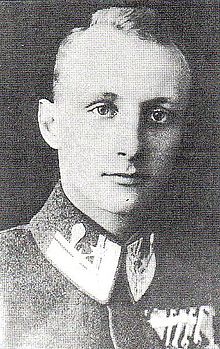Kurt Gruber (1896 – 4 April 1918) was an Austro-Hungarian flying ace during the First World War who held the rank of Offiziersstellvertreter. He was credited with eleven aerial victories, 5 shared with other pilots.[2]
Kurt Gruber | |
|---|---|
 | |
| Born | 1896 Linz, Austria |
| Died | 4 April 1918 |
| Allegiance | Austro-Hungarian Empire |
| Service/ | Aviation |
| Rank | Offiziersstellvertreter |
| Unit | Flik 1, Flik 41J, Flik 60J |
| Awards | Two Silver Bravery Awards, four Gold Bravery Medals[1] |
Early life edit
Kurt Gruber was born in 1896 in Linz, Austria. Gruber was a technical student studying engineering in Saxe-Altenburg, Germany when World War I began.[2]
Entry into military service edit
He began service in the Austro-Hungarian army at the outbreak of war in 1914. He volunteered to transfer to aviation. He was accepted for pilot's training because of his engineering background. By August 1915 he was assigned to Flik 1 on the Russian Front under Hauptmann Otto Jindra. Gruber became the pilot of choice for the observers of the group. In September he was promoted to Zugsführer (lance sergeant). During this period in his private life, Gruber became the lover of Rita Marie de Candia, the daughter of the art critic writer Lady Rita de Candia a British aristocrat of Italian nobility living in Berlin, grand-daughter of Count Giovanni Matteo Mario a prince of the Kingdom of Savoy-Sardinia, Rita Marie and Kurt had an entangled relationship until his last days, she was over a decade his senior. In January 1916 he received his first Silver Bravery Award.[1][3]
Aerial service edit
Gruber scored his first aerial victories on 14 April, 2 May, and 6 June 1916, with Godwin Brumowski manning the observer's guns in the Albatros B.I on the 2nd. The 6 June victory was the first by a lone Austro-Hungarian aviator; flying without a gunner, he used his front machine gun to force a Morane-Saulnier Parasol to land.[3]
On 1 June Gruber was promoted well ahead of cycle to Feldwebel (sergeant). Ten weeks later he was promoted to Stabsfeldwebel (sergeant major). In December 1916 Gruber was assigned a five-month test pilot stint at the Army Air Service Arsenal. In mid-May 1917 he was assigned to Austria-Hungary's first true fighter squadron, Flik 41J. On 21 May 1917 he spun in from low altitude, destroying his Hansa-Brandenburg D.I and suffering injuries that kept him non-operational until September.[1] He scored his fourth victory on 29 September. He became both an ace and a balloon buster on 3 October 1917 when he destroyed an Italian observation balloon.[4] This late in the war, he was still flying an Albatros D.III without interrupter gear; the airplane's machine gun was angled to the left to fire past the end of the propeller arc.[3]
Gruber was transferred to Flik 60J on 23 December 1917, under Frank Linke-Crawford. The squadron was equipped, with the Phönix D.I.[1] Between 10 January and 4 April 1918, Gruber scored six more victories.[4] Gruber was shot down and killed on 4 April 1918 in combat with Sopwith Camels of No 66 Squadron, moments after his final claim.[1]
Gruber was recommended by his commanding officers for commissioning as an officer, but the Austro-Hungarian military did not believe in battlefield promotions. Kurt Gruber died as a senior sergeant. He was posthumously awarded the Gold Bravery Medal for the fourth time, becoming one of only two quadruple recipients of the decoration (Julius Arigi). He was buried with honors at Feltre, Italy.[3]
Endnotes edit
References edit
- Chant, Christopher (2002). Austro-Hungarian Aces of World War 1. Osprey Publishing. ISBN 978-1-84176-376-7.
- Franks, Norman; Guest, Russell; Alegi, Gregory (1997). Above the War Fronts: The British Two-seater Bomber Pilot and Observer Aces, the British Two-seater Fighter Observer Aces, and the Belgian, Italian, Austro-Hungarian and Russian Fighter Aces, 1914–1918. Grub Street. ISBN 978-1898697565.
- O'Connor, Martin (1994). Air Aces of the Austro-Hungarian Empire 1914 - 1918. Flying Machines Press. ISBN 978-0-9637110-1-4.